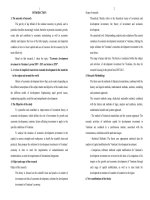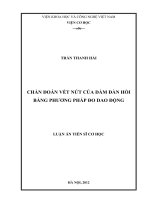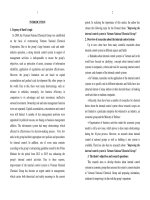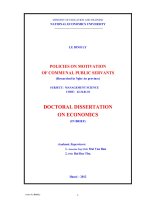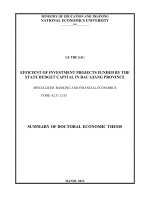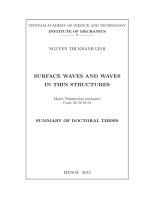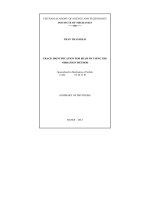TÓM tắt TIẾNG ANH LUẬN án CHUẨN đoán vết nứt của dàm BẰNG PHƯƠNG PHÁP đo DAO ĐỘNG
Bạn đang xem bản rút gọn của tài liệu. Xem và tải ngay bản đầy đủ của tài liệu tại đây (525.54 KB, 26 trang )
VIETNAM ACADEMY OF SCIENCE AND TECHNOLOGY
INSTITUTE OF MECHANICS
o0o
TRẦN THANH HẢI
CRACK IDENTIFICATION FOR BEAM BY USING THE
VIBRATION METHOD
Specialized in Mechanics of Solids
Code: 62 44 21 01
SUMMARY OF PhD THESIS
HANOI – 2012
The thesis has been completed at The Institute of Mechanics,
Vietnam Academy of Science and Technology
Supervisors: Professor, Dr.Sc. Nguyen Tien Khiem.
Assoc. Prof. Dr. Nguyen Viet Cuong
Reviewer 1: Professor, Dr.Sc. Dao Huy Bich
Reviewer 2: Prof. Dr. Hoang Xuan Luong
Reviewer 3: Assoc. Prof. Dr. Tran van Lien
Thesis is defended at The Institute of Mechanics, VAST
on , Date Month Year 2012
Hardcopy of the thesis can be found at
1. Vietnam National Library
2. Library of Institute of Mechanics
1
INTRODUCTION
Since early prognosis of cracks in structures is most important to
keep away from accident, a lot of efforts have been focused to study
cracked structures. This leads to many papers of the topic published in
journals on structural engineering; fracture mechanics; vibrations and
control etc.
Content of the intensive study consists mainly of two problems.
The first one is known as the forward problem that investigates
structural behaviour with given position and size of cracks. The
remaider acknowleged as the inverse problem relates to identify the
potential cracks from measured behaviour of structure under
consideration. The latter problem has recently received more interest
from practical point of view.
There are two approaches to the inverse problem, now could be
called generally structural damage detection problem or structural
health monitoring. The first one is based on “symptoms” of damage
occurrence that are directly extracted from the measured data by using
different methods of signal processing. This approach is termed by
direct technique. The other one makes use of not only the measured
data but also an artificial model of damaged structure for damage
detection. The damage parameters are identified from fitting the
simulated by model behaviour to the measured one. The latter
approach is called the model-based methods. The advantage of the
model-based methods in comparison with the symptom-based
methods is its ability to encourage the useful knowledge acquired
from study of the forward problem.
The structural behaviour used as diagnostic signal for damage
detection problem is frequently the vibrational characteristics or
dynamic response of structure. This is because of the dynamical
properties of structure contain more information on the structure
condition than the static ones. The methods that use the vibrational
characteristics for damage detection in structure are called the
vibration-based method.
2
Using the model-based methods for structural damage
detection faces the difficulty associated with measurement and
modeling errors and incompleteness of measured data. The latter
issues may make the problem of structural damage detection be ill-
posed. The common way to overcome the disturbs is (a) refining the
model of damaged structure with aim to decrease modeling error in
compution of the structure behaviour; (b) applying the modern
mathematical methods that could reduce the effect of measurement
error and allow to obtain consistent solution of the ill-posed inverse
problem; (c) exposing more information on the structure condition
from limited amount of measured data.
The purpose of present thesis is to develop an efficient
procedure for crack identification in beam from measured mode shape
and response to moving load using the well known Tikhonov
regularization method and wavelet transform.
Outline of thesis is as follows
Chapter 1. Overview on vibration-based method for structural
damage detection problem.
Chapter 2. Theoretical background for regularization method,
wavelet transform and model of cracked beam.
Chapter 3. Mode shape-based procedure for multiple crack
detection by using the Tikhonov’s regularization method.
Chapter 4. Reponse of cracked beam to moving load and crack
detection by the wavelet analysis of moving vehicle vibration.
Concluding remarks and Referenses.
Chapter 1. OVERVIEW
Structural damage is understood as a change in either physical
or geometrical properies of structure in comparison with a baseline
configuration of intact structure. Damage is often described by its
position and degree.
The structural damage detection problem was firstly
investigated by Adams etc [1] for a bar with single damage modeled
by an axial spring at a position in bar. The authors have obtained an
equation allowing one to determine the damage position from
3
measured pair of natural frequencies. Latter in [28] Liang and his
coworkers extended the result for the case of beam by establishing
general form of frequency equation of beam with single crack
represented by a torsional spring. Morassi [39] proposed a first order
approximate frequency equation for cracked beam with variable
stiffness. Narkis [40] has calculated analytical solution of the problem
for crack localization from measured two frequencies of simply
supported beam. Nguyen Tien Khiem và Dao Nhu Mai [41]
investigated in detail change in natural frequencies versus crack
position and depth for beam with different cases of boundary
conditions. Salawu [52] presented an overview on the frequency-
based damage detection for structure. The problem gets to be more
complicated when number of damages increased. Ostachowicz và
Krawczuk [43] constructed frequency equation for beam with double
crack in the form of 12×12 determinant. Shifrin và Ruotolo [55], by
using the delta function for representation of change in stiffness at
crack position obtained the frequency equation for beam with arbitrary
number n of cracks in the form of determinant of order n+4. Khiem và
Lien [21] used the transfer matrix method for deriving the frequency
equation of beam with n cracks of the form of 4x4 determinants.
Zhang and coworkers [61] have engaged the equation given by Khiem
và Lien [21] for multi-crack detection from measured natural
frequencies. Following Liang [28], Patil and Maiti [45] have obtained
perturbation equation for natural frequencies of multiple cracked beam
based on the energy conception. Recently, Lee [24] developed the
sensitivity method for crack detection from natural freuencies by
using the finite element formulation. Fernández-Sáez etc [14]
introduced Rayleigh quotient to represent explicitly the first natural
frequency of beam with single crack in term crack position and size.
This generalized Rayleigh quotient gives good approximation only for
the fundamental frequency so that it is inadequate for solution of the
crack detection.
Generally, the frequency-based method of crack detection is
limited by that very small number of frequencies could be available
and cracks at different positions may produce identical change in a
frequency. Therefore, solution of the damage detection problem by
4
using frequencies is often non-unique. In such the case in order to
have unique solution one has to engage other features of structure that
could be axtracted from measurements. The mode shape of structure
was early used for structural damage detection by Rizos et al [51],
Yuen [60], West [65]…. At the first time, the mode shape has been
taken in use for calculating different damage indices such as Modal
Assurance Criteria (MAC) that is unable to be used for damage
localization in structure. Then, Kim and his coworkers [20] have
developed PMAC hay COMAC for the problem but they exposed to
be insensitive to damage. Despite that Ho and Ewins [16], Parloo et al
[46] proposed different damage indices calculated from given mode
shape or its derivatives, Pandey etc [44] demonstrated that the mode
shape is less sensitive to damage than mode shape curvature. Based on
the idea, Ratcliffe [49], Wahab and De Roeck [63] have developed
different procedures for damage localization from mode shape and
mode shape curvature.
Through studying vibration of multiple cracked beam, Li [27]
has derived a recurrent relationship between mode shape if the beam
in both sides of a crack. However, this is not a closed form solution
for the mode shape so that it cannot be used for crack detection from
measured mode shape. By using the step function Caddemi và Caliò
[4] obtained closed form solution for mode shape of beam with
arbitrary number of cracks that is an explicit expression of the mode
shape through crack parameters. The closed form solution of mode
shape has not been taken in use for multiple crack detection because it
contains Dirac delta function.
Although the mode shape of damaged structure could provide
more useful information on the damage circumstance of a structure,
measurement of mode shape is more difficult. The change in mode
shape due to damage is usually more difficult to be monitored than its
shift caused by measurement error. Hence, solving the problem
associated with measurement erroneous in using mode shape for
structural damage detection presents a great interest.
5
Chapter 2. THEORETICAL BACKGROUND
2.1. Tikhonov’s regularization method
2.1.1. Conception of inverse problem
The essential content of inverse problem is to determine the
“cause” with known “consequent”, Tarantola [56]. This problem was
investigated early in Mechanics as determining the force applied to a
body from given its movement trajectory. Recently, a novel
formulation of the inverse problem has come from the practical
demands: “establishing model of an existing object from its observed
current behavior”. This is very complicated problem that is research
subject in different fields of science and engineering and so far to be
completely solved. The problem, called system identification, is also
the substance of the condition monitoring of existing structures.
The crucial attributes of the inverse problem are strong
sensitivity of solution to either modeling or measurement inaccuracy
and having non-unique solution because of incompleteness of given
data. One of the most effective methods in solving the problem is
proposed by A.N. Tikhonov that is called the regularization method
and briefly described below.
2.1.2. Regularization method
A lot of problems in science and engineering leads to solve the
equation
,bAx
=
(2.1)
where A is an arbitrary matrix (might be nonsquare or singular), b is a
vector that is determined only as an approximation to unknown exact
one
.b
Tikhonov và Arsenin [57], [58] suggested that solution of
equation (2.1) can be found from solution of the mean square problem
},{minarg
2
0
2
)xL(xbAxx −+−= α
x
RLS
(2.2)
with
0
x,, L
α
being regularization factor, regularization operator and a
prior information about solution respectively. Leaving outside the
equivalence between equations (2.1) and (2,2) one is going to consider
equation (2,2).
6
Theorema. For
0f
α
solution of equation (2.2) can be found
uniquely from the equation
.)(
0
LxLbAxLLAA
TTTT
α+=+
α
(2.3)
Obviously, when
0→
α
solution of equation (2.3) becomes the
conventional mean square solution
.)(xx
1
bAAA
TT
LSRLS
−
=→
The regularization factor
α
is chosen as solution of the
equation
,
RLS
δα
=− bAx )( (2.4)
where
δ - noise level of vector b.
In turn, equation (2.3) can be solved by using the Singular
Value Decomposition (SVD) of matrix A
T
VΣUA = (2.5)
where
VU,
are square matrices of order m and n respectively and
n
T
m
T
IVV,IUU == , matrix ).,min(},, ,{)(
1
nmqdiagnm
q
=
=
×
σ
σ
Σ
Hence, solution of equation (2.3) with
0x =
0
is
,
ˆ
1
2
k
r
k
k
T
kk
v
bu
x
∑
⎥
⎦
⎤
⎢
⎣
⎡
+
=
=
σα
σ
(2.6)
2.2. Wavelet transform
The Fourie transform was the most powerful tool in signal
analysis in frequency domain. However, it cannot be used for analysis
of non-stationary processes when frequency is dependent upon time.
This gap can be fulfilled by using the newly developed wavelet
transform that is briefly described below.
2.2.1. Difinition of wavelet transform
The continuous wavelet transform is defined as
,)()(),(
,
∫
=
+∞
∞−
dtttfbaW
ba
ψ
(2.7)
where
),()/1()(
*
,
a
bt
at
ba
−
=
ψψ
(2.8)
a is a real number acknowledged as scale or dilation factor, b is
transition,
()
t
ψ
is called mother wavelet function and
(
)
t
*
ψ
is the
7
complex conjugate of
(
)
t
ψ
. For every value of a and b, W(a,b) is
determined as wavelet coefficient of the given signal f(t).
Inverse wavelet transform is
∫∫
=
+∞
∞−
+∞
∞−
−
2
,
1
),()(
a
da
dbbaWCtf
bag
ψ
(2.9)
where
.
)(
ˆ
2
2
∞<
∫
=
∞+
∞−
ξ
ξ
ξψ
π
dC
g
(2.10)
From mathematical point of view, wavelet is convolution of the
signal and wavelet function, allowing compressing a signal.
2.2.2. Application of wavelet
Wavelet is widely used in signal processing, especially in
detecting descontineous of a signal. It can be utilized also for
detecting similarity of signals, filtering or compressing signals.
Recently, wavelet has been used for local damage detection in
structures through wavelet analysis of response of structure.
2.3. A model of multiple cracked beam
2.3.1. A crack model
It was approved in Fracture Mechanics that a crack occurred at
a section of beam member introduces local flexibility could be
calculated by the formulae
),()/6(/ sFbEIhMc
I
π
φ
=
Δ
= (2.11)
where h, b are high and wide of the beam’s rectacular cross section, EI
is the bending stiffness, s = a/h is relative crack depth and
)(sF
I
is an
experimental function
. In such the case, crack can be represented by a
torsional spring of the stiffness
)).(6/(/1 shFbEIcK
I
π
=
= (2.12)
This idea constitutes the most simple and efficient model of crack in
beam member.
2.3.2. Model of beam with crack
The rotational spring model of crack allows one to represent a
crack at a section in beam in a form of compatibility conditions at
crack that should be satisfied by the displacements and forces of beam
8
in both sides of crack. The study of cracked beam with the crack
model can be carried out by dividing the beam into sub-beam
bordered by crack position and beam ends, Rizos và cộng sự [51].
This approach enables to use the governed equations without any
change for solving the problems of cracked structures.
2.3.3. Finite element model of beam with crack
Qian et al [48], have shown that stiffness matrix of a cracked
beam can be expressed as
.
Tee
c
TCTK
1
~
−
= (2.13)
Where
T
e
l
⎥
⎦
⎤
⎢
⎣
⎡
−
−−
=
1010
011
T
and the flexibility matrix
)1()0(
~
ijij
e
ij
CCC +=
with
.
2
23
2
23
)0(
⎥
⎥
⎥
⎥
⎦
⎤
⎢
⎢
⎢
⎢
⎣
⎡
=
EI
l
EI
l
EI
l
EI
l
ee
ee
C (2.14)
and
⎥
⎥
⎥
⎦
⎤
⎢
⎢
⎢
⎣
⎡
+
=
11
2
1
2
2
1
2
)1(
2
2
2
nRRnL
RnLmR
RnL
e
e
e
C , (2.15)
.,,
'
36
,
'
36
0
2
2
0
2
1
24
∫
=
∫
===
a
II
a
I
daaFRdaaFR
bhE
m
bhE
n
ππ
l
e
– the length of
element, a is crack depth.
Summary of Chapter 2
In this Chapter, the fundamental of the Tikhonov’s relarization
and Wavelet transform methods has been presented. The
regularization method allows obtaining unique solution of the standard
inverse problem with noisy measured data. The wavelet transform is
an helpful tool in detecting small change in response of structure due
to damage. Additionally, the continuous and finite element models of
cracked beam are briefly described.
9
Chapter 3
CRACK DETECTION BY NATURAL FREQUENCIES AND
MODE SHAPES
3.1. An explicit expressions of frequency and mode shape of
multiple cracked beams
3.1.1. Generalized Rayleigh quotient for multiple cracked beam
Consider a beam free vibration of which is described by
equation
,2,1,,0)()(
2
44)(
===− k
EI
F
xx
k
kkk
IV
k
ωρ
λφλφ
(3.1)
where
,
2
k
ω
),(x
k
φ
,2,1=k denote the natural frequencies and
associated mode shapes. Suppose that the beam length is divided into
N segments
Njxx
jj
, ,1),,(
1
=
−
, each of them contains a crack ),(
jj
Ke
such that
Njxex
jjj
, ,1,
1
=
<<
−
, .,0
0
Lxx
N
==
Rayleigh quotient for the beam is conducted in the form
[]
∑
⎥
⎦
⎤
⎢
⎣
⎡
∫
∑
−+
⎥
⎦
⎤
⎢
⎣
⎡
∫
+
=
=
−
=
−
N
j
j
x
j
x
kj
N
j
kkN
j
x
j
x
jkjjkj
k
dxx
BLBxdxx
F
EI
1
1
2
1
1
1
22
2
)(
)0()()(")("
φ
φγφ
ρ
ω
. (3.2)
Let the eigen-functions be chosen in the form
),()()(
0
xxx
c
kjkkj
φφφ
+= (3.3)
with
)(
0
x
k
φ
being mode shape of uncracked beam that is continuous
together with its derivatives
),(
0
x
k
φ
′
),(
0
x
k
φ
′
′
)(
0
x
k
φ
′
′
′
everywhere along
the beam length (0, L) and linear functions
⎪
⎩
⎪
⎨
⎧
≤−
′′
≤
++=
−
−
10
1
),()(
,0
)(
jjjjkj
jj
jkkj
c
kj
xxeexSx
exx
DxCx
p
p
φγ
φ
(3.4)
,
kj
C
kj
D are constants and ,2/]sin[sinh)(
λ
λ
λ
xxxS
+
=
• For simply supported beam the equation (3.2) is
,
sin.sin
3
)(2
sin41
sin21
1,
4
1
2
1
22
0
2
⎥
⎦
⎤
⎢
⎣
⎡
∑
+
∑
+
⎥
⎦
⎤
⎢
⎣
⎡
∑
+
=
==
=
jj
N
ji
ii
j
i
N
j
jj
N
j
jjk
k
ekekq
k
ek
ek
πγπγ
π
πγ
πγω
ω
(3.5)
10
If cracks are small,
,
jj
εη
γ
=
the asymptotic approximation of
equation (3,5) with regard to small parameter
,
ε
is
.sin21
1
22
0
2
⎥
⎦
⎤
⎢
⎣
⎡
∑
−=
=
N
j
jjkk
ek
πγωω
(3.6)
In the case of single crack equations (3.5), (3.6) respectively become
[]
,
sin)](3/))1([(2sin41
sin21
242222
1
22
0
2
jiijj
N
j
jjk
k
ekkeeek
ek
ππγπγ
πγω
ω
−++
⎥
⎦
⎤
⎢
⎣
⎡
+
=
∑
=
(3.7)
[
]
.sin21
ˆ
22
0
2
jjkk
ek
πγωω
−= (3.8)
• For cantilever, with
,0
00
==
kk
DC the Rayleigh quotient is
⎥
⎦
⎤
⎢
⎣
⎡
∑
ΦΦ+
∑
Φ+
⎥
⎦
⎤
⎢
⎣
⎡
∑
Φ+
=
==
=
N
ji
ikjkji
j
i
k
N
j
jkj
N
j
jkjk
k
eeqe
e
1,
4
0
1
2
1
22
0
2
)()(
3
)(21
)(1
γγ
λ
γ
γω
ω
(3.9)
with the first order approximation
⎥
⎥
⎦
⎤
⎢
⎢
⎣
⎡
∑
Φ−=
=
N
j
jkjkk
e
1
22
0
2
)(1
γωω
. (3.10)
The formulas for beam with single crack are
[
]
2/1
234
0
2
0
)()6/)1(1(21
)(1
⎥
⎥
⎦
⎤
⎢
⎢
⎣
⎡
Φ−++
Φ+
==
jkjk
jkj
k
k
k
ee
e
γλγ
γ
ω
ω
ω
(3.11)
and
[
]
.)(1
~
2/1
2
jkjk
eΦ−=
γω
(3.12)
If beam has two cracks one has
[
]
[]
,
),,,()()(21
)()(1
2/1
21212
2
21
2
1
2
2
21
2
1
0
⎥
⎦
⎤
⎢
⎣
⎡
Ψ+Φ+Φ+
Φ+Φ+
==
eeee
ee
kk
kk
k
k
k
γγγγ
γγ
ω
ω
ω
(3.13)
[
]
2/1
2
2
21
2
1
)()(1
~
ee
kkk
Φ−Φ−=
γγω
. (3.14)
3.1.2. Explicit expression for mode shape
Consider the beam with n cracks at
nje
j
, ,1,
=
. Assume that
the cracks are modeled by spring of stiffness
), ,1(
0
njK
j
=
that can
be calculated from crack depth
)., ,1( nja
j
=
The governed equation for natural mode is
),1,0(,0)()(
4)(
∈=Φ−Φ xxx
IV
λ
4
2
/ EIFL
ωρλ
= . (3.15)
11
Introducing the function
)sin)(sinh2/1()( xxxS
λ
λ
λ
+
=
(3.16)
One can express solution of equation (3.15) in segment
njee
jj
, ,1],,[
1
=
+
, satisfying the compatibility conditions at cracks, Li
[27] , as
njexSexx
jjjjjj
, ,1),()()()(
11
=
−
′
′
+
=
−−
φ
γ
φ
φ
.
Putting previous equation into subsequent one and introducing the
notations
njeeSe
j
k
kjkjjj
, ,1],)()([
1
1
0
=
∑
−
′′
+
′′
=
−
=
μφγμ
, (3.17)
and
⎩
⎨
⎧
≤
=
0),(
00
)(
fxxS
x
xK
, (3.18)
One can express general solution of equation (3.15) in the form
,)()()(
1
0
∑
−+Φ=Φ
=
n
k
kk
exKxx
μ
(3.19)
where
)(
0
xΦ is general solution of equation (3.15) for uncracked beam
that can be expressed as
),(),(),(
210
λ
λ
λ
xDLxCLx
+
=
Φ . (3.20)
with constants C, D and functions
),(),,(
21
λ
λ
xLxL satisfying
boundary conditions at the left end of beam.
Afterward, one gets
,),,(
)(
)],(),(),([
1
0
1
21
∑
=−
′′
∑
+
′′
+
′′
=
=
−
=
n
k
kkj
j
kj
j
jk
kjj
eeb
L
eeSxLDxLC
μλ
λ
γ
λμλλγμ
(3.21)
Using the matrix notations
{}
,, ,)(
1 n
diag
γ
γ
=γΓ ], ,1,),,([),( nkjeebbe
kjjk
=
=
=
λ
λ
B (3.22)
{}
,, ,
1
T
n
μμ
=μ
{
}
;, ,
1
T
n
ee=e
{
}
T
n
γγ
, ,γ
1
= ,
equation (3.21) can be rewritten as
[]
.0)(),()(
0
=− μIBΓ
λλγ
Le
(3.23)
From equation (3.19) one can express modal slope and curvature in
the form
∑
=Φ=Φ
=
n
j
rjjr
l
r
l
r
l
exCxx
1
)()()(
),,()(),(
μλαλ
(3.24)
12
Corresponding to slope when
1
=
l and curvature if 2
=
l .
3.2. Numerical results
3.2.1. Natural frequencies
Table 3.1. Comparison of calculated frequencies with experiment
Table 3.2. Comparison of frequencies calculated versus crack depth
for simply supported beam with published results.
3.2.2. Mode shapes
Purpose of calculating mode shape of multiple cracked beam is
to analize the effect of position, depth and amount of cracks on the
mode shape.
Numerical results allow one to make the following remarks.
1. Mode shape is really undergos abrupt change at the crack position,
but magnitude of the change is not significant. There are found out
positions in beam crack occurs at which does not change mode shape.
Such the points are called unaffected for mode shape.
2. Disimilarly to the unaffected points of frequency, the unaffected
point of mode shape appear even for the first mode and either position
or quantity of the mode shape unaffected points for a given mode
could be changed in dependence on the crack position.
3. In the case of symmetry of boundary conditions effect of crack
position on mode shape is also symmetrical. Two cracks at positions
symmetric through the middle of beam may annualize effect of each
other on the mode shape.
13
3.3. Multiple crack detection by frequency and mode shape
3.3.1. The problem and solution
Assume that m
f
natural frequencies
(
)
,, ,
**
1
mf
ωω
are available so
that corresponding eigenvalues
frr
mrFL ,,2,1,
4
2**
==
ρωλ
can be
calculated. Moreover, suppose that mode shapes have been measured
at positions (x
1
, …x
m
) as
{
}
mjmrx
fj
l
rrj
, ,1,, ,1),(
)(*
==Φ=
φ
.
It is required to determine crack position and depth possibly occurred
in beam.
Let the beam contain n cracks of the unknown magnitudes
), ,(
1 n
γ
γ
occurred at the given mesh ), ,(
1 n
ee . If we could determine
the crack magnitude vector
), ,(
1 n
γ
γ
from given natural frequencies
and mode shapes, then crack would be assigned to be at position
k
e if
0f
k
γ
. This is essence of the method of crack detection called crack
scanning technique that is described below.
Using equation (3.19) the mode shape can be calculated at the
mesh (x
1
, …x
m
) and as result one gets the system of linear algebraic
equations
rr
bμA =
(3.25)
where
{
}
;, ,
**
1 rmrr
φφ
=b ];, ,1;, ,1),([)(
**
nkmja
rjkrr
====
λλ
AA
),(),(),(),(),()(
*)(
2
**)(
1
**)(*
rj
l
krrj
l
krrkj
l
rjk
xLeDxLeCexKa
λλλλλλ
++−=
, (3.26)
{}
T
n
μμ
,,
1
=μ - vector of damage indices.
Generally, the system of equations (3.25) is not regular because
the number of equations is usually much less than the number of
unknowns. Moreover, the left hand side of the equations is noisy
measured data so that the system of equiations could be solved only
by using the Tikhonov’s regularization method.
Using SVD method solution of equations (3.25) can be
ontained as
∑
+
=
=
R
k
k
k
r
T
kk
r
1
2
)(
v
bu
μ
σα
σ
(3.27)
14
with the regularization factor
α
is chosen from equation
2
1
2
1
22
2
2
)(
)/1(
)(
)(
δ
ασ
α
=
∑
+
∑
+
=−
+==
m
Rk
r
T
k
R
k
k
r
T
k
rrr
bu
bu
bμA . (3.28)
Afterward, the vector of crack magnitudes can be calculated as
., ,1,
),(
)(
ˆ
,
*
*
0
nj
μb
μL
kr
rkrjk
r
rjr
j
=
∑
∑
=
e
λ
λ
γ
(3.29)
Neglecting negative and zero components in the obtained vector
{}
T
n
γγ
,
ˆ
1
=γ gives the desired crack magnitudes
{
}
ci
ni , ,1,
=
γ .
Subsequently, one will have crack positions
{
}
ci
nie , ,1,
=
detected.
3.3.2. Procedure for multiple crack detection
Step 1:
Assign a mesh
{
}
1, 0
21
≤
≤
n
eee pp for scanning cracks in
beam of the unknown magnitudes
{
}
.,
1
T
n
γγ
=γ
Step 2:
Based on the crack mesh
), ,(
1 n
ee
, the equations (3.25), (3.26)
and expression (3.27) are constructuted for every mode.
Step 3:
Solving equation (3.28) with a given noise level leads first the
factor
α
ˆ
to be found and then solution )
ˆ
(
ˆ
α
k
μ to be calculated by
equation (3.27).
Step 4:
Calculating the vector
{
}
T
n
γγ
,
ˆ
1
=γ
by using equation (3.29)
and neghlecting the negative and zero components give rise
{}
ci
ni , ,1, =γ
;
Step 5:
On the plotting of the vector
{
}
ci
ni , ,1,
=
γ versus crack
position mesh
{}
ci
ni , ,1, =e in the ),(
γ
e - plane obvious peaks give
thedetected crack positions.
Step 6:
Handling the steps 1-4 with the obtained above detected crack
mesh one will have got finnaly desird crack magnitudes.
3.3.3. Numerical results
The noisy left hand side of equation (3.25) is simulated by
mj,
m
E
j
p
jj
, ,1
*
=+= N
σ
φφ
, (3.30)
15
with
p
E being noise level,
σ
- standard deviation of calculated
mode shape
j
φ
))((
j
std
φ
σ
= and ), ,1, mj
j
=N( is a vector of m
random values of normal distribution with zero mean and unique
deviation. A beam with L = 0,8m, b = 0,02m, h=0,02m, E =
2,06×10
11
N/m
2
, ρ = 7800kg/m
3
, three cracks at 0,2; 0,5 và 0,7 of the
same depth running from 0,1÷ 0,6 is considered.
Table 3.3. Result of crack detection extracted from Figure 3.1 (noise
level 3%)
Table 3.4. Result of crack detection extracted from Figure 3.2
(number of measurement points 40)
Table 3.5. Result of crack detection extracted from Figure 3.3 (40
measurement points and noise level 2%)
16
Figure 3.1. Crack magnitude versus crack scanning mesh with noise
level 3%, crack depth a/h = 0,5; number of points in the scanning
mesh 10,…, 60.
Figure 3.2. Crack magnitude versus crack scanning mesh with crack
depth 50%, number of measurement points 40, noise level from 0% to
10%.
Figure 3.3. Crack magnitude versus crack scanning mesh for noise
level 2%, 40 measurement points, crack depth from 10% to 60%.
Observing the numerical results leads to the conclusions
Cracks in beam might be exactly localized by spairse
measurements at 10 sites if scanning mesh is chosen properly and
increasing the number of measurement points of course improves the
result of crack localization. However, some false cracks can be
observed near the free end of beam even in the case of small noise
17
level. This miscalculation disappears for suitablely chosen
measuremet and scanning grids.
Measurement noise is really the factor that may cause serious
difficulty for crack detection in beam. In spite to that the crack
scanning method might consistently localize cracks if noise level does
not exceed 10% in dependence also on the crack depth. The cracks of
depth limited to 10% could be detected if measurement noise is small.
The more crack depth the easier to exactly detect the crack,
especially, when crack depth exceeds 20% it is detected consistenly.
For the cracks of depth less than 20% and noise level up to 2% the
regularization is not required. The free of noise measured data allow
exact detection of cracks with depth about 1% beam high.
The numerical results have been obtained only by using the
first mode shape and the higher modes do not improve the crack
detection. This can be explained probably by influence of the mode
shape node on the crack detection procedure. However, the
fundamental mode shape is always mostly easily measured in practice.
Summary of Chapter 3
The main results of this Chapter are Rayleigh’s quotient
expanded to multiple cracked beam that is an explicit expression of
natural frequencies in term of crack parameters; the explicit
expression of mode shape for the beam that is important tool for
analysis and identication of multiple cracked beam; a procedure for
crack detection from measured mode shape with noise level up to
10%.
Chapter 4. CRACK DETECTION BY WAVELET
4.1. Vibration of beam under moving loads
4.1.1. Model of ¼ vehicle
The equation of motion of the vehicle [33]
(
)
(
)
,0
010
1
1
=−+−+ wykwycym
&&&&
(4.1)
Finite element model of cracked beam under moving load
,
0
f
T
NfKddCdM ==++
&&&
(4.2)
18
f
0
- the load from moving vehicle.
Figure 4.1. Simply supported beam under moving load of ¼ vehicle.
4.1.2. Model of ½ vehicle
Figure 4.2. Simply supported beam under moving load of ¼ vehicle.
The governed equation of vehicle, Jazar [19]
+
⎪
⎪
⎭
⎪
⎪
⎬
⎫
⎪
⎪
⎩
⎪
⎪
⎨
⎧
⎥
⎥
⎥
⎥
⎥
⎦
⎤
⎢
⎢
⎢
⎢
⎢
⎣
⎡
+−
+−−
−−+−
−−+
+
⎪
⎪
⎭
⎪
⎪
⎬
⎫
⎪
⎪
⎩
⎪
⎪
⎨
⎧
⎥
⎥
⎥
⎥
⎥
⎦
⎤
⎢
⎢
⎢
⎢
⎢
⎣
⎡
4
3
2
1
42222
31111
21212211
221122112
2
21
2
1
4
3
2
1
2
1
0
0
0
0
000
000
000
000
d
d
d
d
ccccb
ccccb
cccccbcb
cbcbcbcbcbcb
d
d
d
d
m
m
m
I
&
&
&
&
&&
&&
&&
&&
.
0
0
0
0
2424
1313
4
3
2
1
42222
31111
21212211
22112211
2
22
2
11
⎪
⎪
⎭
⎪
⎪
⎬
⎫
⎪
⎪
⎩
⎪
⎪
⎨
⎧
+
+
=
⎪
⎪
⎭
⎪
⎪
⎬
⎫
⎪
⎪
⎩
⎪
⎪
⎨
⎧
⎥
⎥
⎥
⎥
⎥
⎦
⎤
⎢
⎢
⎢
⎢
⎢
⎣
⎡
+−
+−−
−−+−
−−+
+
wcwk
wcwk
d
d
d
d
kkkbk
kkkbk
kkkkbkbk
bkbkbkbkbkbk
&
&
(4.3)
Finite element equation of beam
.
2211
ff
TT
NNKddCdM +=++
&&&
(4.4)
19
4.2. Response of beam to the moving load
• The model of ¼ vehicle : (Figure 4.1)
Consider beam with L = 50m, ρ = 7860 kg/m
3
, E =
2,1×10
11
N/m
2
, cross section b×h = 0,5×1,0m. Assume that two cracks
appear at positions L/3 and 2L/3 of the beam. The parameters of
vehicle are taken those of Reference Majumder [37].
a) v = 1m/s b) v = 4m/s
Figure 4.3. Vibration of vehicle for the case of uncracked ( ) and
cracked ( ) beam in different speeds of moving.
a) vận tốc v = 1m/s b) vận tốc v = 5m/s
Figure 4.4. Vibration of vehicle in the case of different crack depth.
• Model of ½ vehicle: (Figure 4.2)
Beam parameters are ρ = 7855kg/m
3
, E = 2,1×10
11
N/m
2
,
L=50m, b = 1m, h = 2m. Cracks at the positions L
c1
= L/3 và L
c2
=
2L/3 have the same depth. Vehicle parameters are of Reference Deng
et al [11],
20
a) v = 2m/s b) v = 5m/s
c) v = 20m/s d) v = 40m/s
Figure 4.5. Vibration of vehicle for the case of uncracked ( ) and
cracked ( ) beam in different speeds of moving
4.3. Wavelet analysis of beam response to moving load
The load calculated from the vibration of vehicle is added by
random noise
)( yEyy
oisepoise
σ
N
+
=
(4.5)
y – calculated vertical displacement of vehicle, E
p
noise level, N
oise
a
random vector of normal distribution with mean 0 and standard
deviation 1,
σ
(y) standard deviation of y, y
oise
noisy displacement of
vehicle.
4.4. Crack detection by wavelet
• Wavelet transform of beam response to ¼ vehicle
Figure 4.6. a/h = 0 , v =1 m/s.
Figure 4.7. a/h=0,1 v = 1 m/s.
21
Figure 4.8. a/h=0,3 v=1 m/s.
Figure 4.9. a/h=0,5 v=1 m/s.
Figure 4.10. a/h=0,5; v = 0,5 m/s.
noise level E
p
= 0%, noise level E
p
= 5%.
• Wavelet transform of beam response to ½ vehicle
Figure 4.11. a/h = 0,0; v = 2m/s.
Figure 4.12. a/h = 0,1; v = 2m/s.
Figure 4.13. a/h = 0,3; v = 2m/s.
Figure 4.14. a/h = 0,5; v = 2m/s.
22
Figure 4.15. a/h = 0,5; v = 30m/s.
Figure 4.16. v = 2m/s, noise 0%, noise 6%.
Observation of the figures leads to the following conclusions
In the case of uncracked beam no clear peack is visible on the
wavelet graphics. However, the wavelet coefficient with scale 40 for
cracked beam it is obvious two peacks at L/3 and 2L/3, the actual
crack positions. The peacks show a distortion of the beam response.
The peacks become more apparent with increasing crack depth
a/h from 0,1 to 0,5. This implies the fact that the more severe crack
the more obvious the crack appears in the wavelet diagram so that it is
easier to detect such crack.
For ½ vehicle model the wavelet diagram at scale 50 peacks
appeared at time moments t = 5,3; 8,3, 13,7; and 16,7s, among which
the points t = 5,3s and t = 8,3s correspond to the time when two legs
passed across the crack position L/3 and peacks at t = 13,7s và t =
16,7s correspond to passing of the legs across second crack at 2L/3.
Consequently, peacks at the wavelet diagrams are really
indicators of presence of cracks and the peacks are apparent for the
measurement noise up to 6%.
23
Summary of Chapter 4
In this Chapter the models of ¼ and ½ vehicle moving on the
cracked beam have been proposed and analyzed in time domain with
the wavelet transform. It has demonstrated influence of crack
parameters, speed of moving vehicle and measurement noise on the
wavelet diagram of the vehicle response. This analysis shows that
GENERAL CONCLUSIONS
The major results obtained in this thesis are as follow:
1. Explicit expressions of natural frequencies and mode shapes have
been derived for multiple cracked beams in term of crack
parameters that can be usefully employed for crack detection by
using the vibration-based method. Particularly, the expressions
are useful tool for modal analysis of multiple cracked beam.
2. Model of cracked beam subject to moving vehicle has been
established and analyzed by using the Finte Element Method and
Newmark procedure.
3. A new procedure has been developed for multiple crack
identification for beam from noisy measured mode shape with
application of the Tikhonov’s regularization method that allows
for obtaining consistent solution of the inverse problem for the
noise level up to 10%.
4. Wavelet transform has been used for analysis of dynamic
response of vehicle moving on the cracked beam and it is shown
that the wavelet coefficients are useful indicators for crack
detection in beam.
A shortcoming of the results is that in both the cases crack depth
is identified inadequately that is topic of further study for the author.
Moreover, the methods developed in this thesis can be extended to
more complicated structures such as frames.
